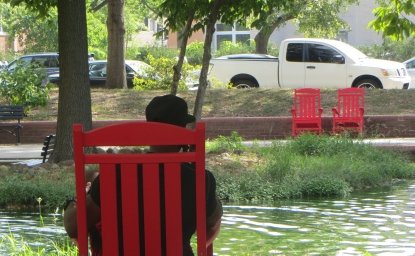Tensions have been rising in many corners of Ukraine as the threat of a Russian intervention looms. Ukraine’s Black Sea port of Odessa is one such corner of dispute between Moscow and Kiev, where macro-battles have been transformed into a seemingly endless chain of micro-conflicts.
Supporters of both countries have taken to marching through the streets, ominously threatening each other. The Ukrainian government is trying to wrest control of the local oil refinery — one of the country’s most important — away from a Russian bank. Tension is visible in the smallest aspects of life.
Odessa’s role as a site of unbridledUkrainian-Russian competition is not surprising. Though within Ukraine, the city is overwhelmingly Russian-speaking. Prominent Russian political figures regularly proclaim their right to take back what was theirs — from Alaska to Finland.
In the case of Odessa, however, such a claim might be have historical justifation.
The city was, after all, a creation of the Russian Empire.
Yet Odessa has existed as a different sort of Russia than today’s nationalists take to be their own. The port city represents a Russia that always has been open to the world, with a wry smile that scoffs at the sort of ruffians and thugs dispatched by Russian President Vladimir Putin to “liberate” the city.
I have traveled to many parts of what is now the former Soviet Union. Even in the carnival-esque wreckage of a collapsed political system, however, nothing quite compares to Odessa. Not just a place, the city is more of a state of mind. (Or, at the very least, a website for a virtual Odessa that exists in the imaginations of thousands of former residents who have moved to places as varied as Tel Aviv, Sydney, Toronto and Brooklyn.)
A “real” Odessa exists as much in the ironic short stories of Odessa Tales by Isaac Babel, who was arrested and shot by Joseph Stalin’s NKVD, as it does in the compelling stage productions of his grandson, Andrei Malaev-Babel, who teaches acting in Florida. Odessa, in other words, is not just a waterfront promenade with a celebrated staircase, stunningly captured in Sergei Eisenstein’sBattleship Potemkin. It is more than just a patch of land over which the Russian imperial, Soviet, fascist Romanian and Nazi, and Ukrainian flags have unfurled at one time or another. Odessa extends from Siberia to Sarasota; prevailing independently from all political claimants. It does so because, throughout its brief yet extravagantly tawdry history, Odessa has always inspired great dreams.
Catherine the Great established the city in 1794 as a frontier settlement. Her Black Sea port quickly emerged as a randy mix of nationalities and cultures. It is a Russian city, yes; but also a Jewish city, a Ukrainian city, a Greek city, and an Italian city. Odessa is all — and none — of the above. It is a cosmopolitan antithesis of the Russian nationalism on the march today. The city’s striking peculiarities — its mix of nationalities, tolerant attitudes, cuisine, dialect, joie de vivre, sense of humor, southern temperament, resourcefulness and entrepreneurial spirit — always defined a distinctive Odessan sense of place. No matter who claimed sovereignty.
The Odessa kaleidoscope was spinning from the very beginning. The city took shape in the mind of a Neapolitan soldier of fortune, José Pascual Domingo de Ribas y Boyons (Osip Mikhailovich Deribas), before it assumed physical form. De Ribas was the child of a Spanish consul and his aristocratic Irish wife. He had entered into Russian service in the 1770s, after a brief stint in the Neapolitan army. Serving on the staff of Catherine’s lover and imperial strategist Grigory Potemkin, the Neapolitan caught the attention of his superiors by watching over and covering for the multiple offenses of the dissolute American Rear Admiral John Paul Jones, who had also come to Russia in search of fortune.
After Russia’s victory over the Ottoman Empire, de Ribas convinced Catherine and Potemkin that a patch of land near the mouths of four major European rivers — the Danube, Dniester, Dnieper and Bug — would make an excellent location for a city. On May 27, 1794, the czarina ordered that a port be built on the site.
Following Russian practice for identifying settlements in the empire’s recently acquired lands in the south, which had been christened “New Russia” — de Ribas’s city was named after a classical Greek hero. In this case, the name Odysseus was feminized to Odessa in honor of Catherine.
De Ribas set out to create a more orderly version of his hometown Naples. In this he succeeded, for the city grew out along a logical grid.
There was nothing well-ordered, though, about the people who filled up that well-engineered civic plan. Odessa attracted a multitude of fortune-hunters and adventurers from around the world. All sorts of folks from a variety of backgrounds were drawn by the opportunity to get rich quick as traders in a city that was growing into one of the world’s biggest commercial ports.
Catherine’s grandson Czar Alexander I replaced de Ribas as “city chief” with the French aristocrat Armand Emmanuel Sophie Septimanie du Plessis, duc de Richelieu, great-nephew of the infamous Cardinal Richelieu, who was fleeing Jacobean revolutionaries in Paris. De Richelieu, who served as governor between 1803 and 1814, set out to promote trade and tried to attract energetic entrepreneurs. He built state-of-the-art infrastructure for the city and it expanded to roughly 20,000 people by the time he stepped down as governor. He is still fondly remembered, though. His statue now stands atop the iconic Potemkin Stairs, an urban ladder that climbed 200 (now 192) steps from the docks to the central districts.
De Richelieu transformed Odessa into a safe harbor for Russia’s least respected social class: the petty bourgeoisie. It drew all those seeking opportunity — tradesmen, shopkeepers, former serfs, Jews fleeing shtetls across the Pale of Settlement, semi-skilled workers and any number of outcasts of various sorts. In Odessa, they were able to build new lives. The city, with its diverse population, also became a cultural center, fostering new forms of Russian literature, theater, song, and media.
A senior Ukrainian diplomat in residence in Washington, who happens to be an Odessan by birth and temperament, recently told me that wherever he went, he felt there was a sprite telling him everything around him was absurd. In the old Soviet days, he explained, this personal sprite would mock the speech of a Communist Party secretary. More recently, the sprite would mock him whenever he was called on to meet with world-famous leaders.
Such sprites, the diplomat said, inhabit the brains of thousands of contemporary Odessites. Their muses will mock Putin’s Russia ceaselessly — until we all understand that no emperor ever wears any clothes.
Throughout its history, Odessa has encouraged a melding, reconciliation, and mutual borrowing of diverse cultural expressions and traditions to produce new amalgams. There can be no greater threat to Putin’s hollow juggernaut than this special place.
A tattered Ukrainian military, even when backed by Western sanctions, may never bring Putinism to an inglorious end. Odessan mockery, however, most certainly will.
http://blogs.reuters.com/great-debate/2014/04/15/odessa-ukrainian-port-that-inspired-big-dreams/






